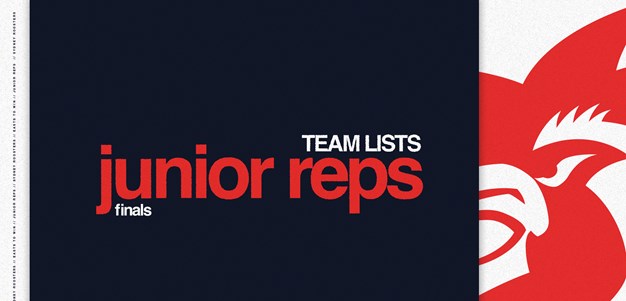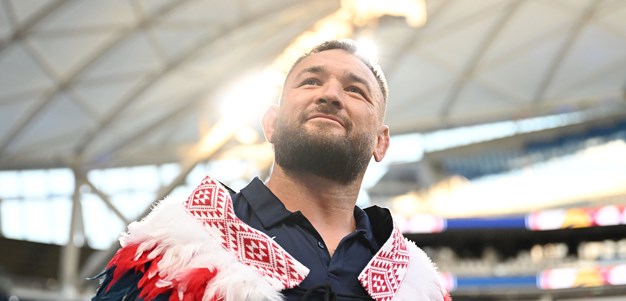Life-long Sydney Roosters fan Alan Katzmann has joined the Roosters.com.au team for the 2013 season and will contribute regular opinion pieces on subjects of interest to our supporters, and league followers in general.
A 12-year Member and Eastern Suburbs local, Alan is one of the tricolours most passionate followers and a proud member of the recently established Jack Gibson Club.
CHOOSING THE IDEAL INTERCHANGE BENCH
In the previous edition of Chiming into the backline I wrote about the significant changes to the roles of back rowers and the subsequent emergence of middle and wide forwards. The interchange benches that clubs therefore choose each week have to take into account the additional workloads of the middle forwards, as well as a raft of other considerations.
First, it is important to note that the average wide forward/second rower will probably need to make fewer than three tackles every eight minutes while a middle forward (lock/prop/hooker) could be expected to make as many as five in the same time. The number of hit-ups expected of a prop, and a lock for that matter, would also exceed that of a second rower by a similar ratio. Therefore, while these middle forwards can all play 80 minutes, it is not possible for most to play effectively throughout a match without getting at least one break to recuperate. The middle forwards also expend far more energy moving up and back in defence than the other eight players in the main defensive line, so the interchange bench needs to be structured around them and their rest periods.
Therefore, an ideal interchange bench would simply comprise cover for the four middle forwards two props, a lock forward and a hooker. Under these circumstances you might plan to use two of your interchanges for hooker, two for lock, five for the two props and leave the final one for a late emergency. However, there is much more to consider before such a simple plan can be enacted.
First, does the selection of your starting 13 and your interchange bench cover you if any of the starting 13 were to be injured during the game? Can one of your second rowers play in the centres if an injury occurred to an outside back? While it is just one position out, many second rowers struggle to play centre, so it is important to consider various scenarios before settling on the right bench. Players like Canberras Joel Thompson and our own Mitch Aubusson are not just among the best second rowers in their club but are at least the fourth-best centre, thus enabling their coaches to not carry an outside back on the bench. You might recall about 10 years ago while Chris Flannery was injured, the Roosters were often forced to carry an outside back on the bench because they had no suitable forward who could play there in an emergency. In two consecutive matches, that interchange player (Todd Byrne) was never used and consequently the forward interchanges in those games were anything but ideal, with only three interchange forwards to choose from. In more recent times, Tim Sheens at Wests Tigers would often carry an outside back for similar reasons and constantly ran into the same problems, often running on the outside back in the last few minutes as the tenth interchange.
At least one of the centres should be able to handle wing and at least one of the three quarters should be able to play fullback (at least in an emergency), so a forward who can play as a centre is a must. If you do not have a starting second-rower with those skills and speed, you might need to sacrifice your bench lock or second hooker for a second rower who can play centre, or carry an outside back for emergencies in his place. In those circumstances each of your remaining middle forwards, particularly the starting lock or hooker, would be required to play considerable additional minutes.
An injury to an inside back can be catastrophic during the match and it is certainly not feasible to carry a specialist inside back on the bench. However, if either your starting hooker or bench hooker is a former inside back (which many are), then that is how you would compensate. It is yet another reason why it is very dangerous not to have a second hooker on the bench. It is rare these days that a lock or a second rower could slip easily into five eighth if that player or the halfback were injured during a game (and the starting five eighth went to half), but there are a few players in the NRL who could possibly handle that task, and that might be how a club would cover if they didnt have a hooker that could play as an inside back or only carried one hooker in their 17.
There are clubs with second rowers who struggle to play 80 minutes of quality but are very effective if used in shorter spells. These tend to be the bulkier second rowers or those who have not played a lot (Frank Pritchard, Tony Williams and Dave Taylor are three that come to mind of the bulkier variety, while young players like Tohu Harris and Tariq Sims are just getting used to the pace of the NRL). Clubs with these types of players will generally carry a second rower on the bench or use them as bench second rowers, and as such would need to sacrifice one of the middle forward bench spots. Players like Dene Halatau, who can play second row and hooker (a very rare combination), and Ryan Hinchcliffe, who can play lock and hooker, become key members of the 17 when you plan to interchange at least one of your second rowers. A rare player who can play lock and second rower in your 17 like Wade Graham and Boyd Cordner would also allow the luxury of carrying a second rower on the bench instead of a lock. For those clubs that go without a specialist second rower on the bench but carry two locks in the 17, they would expect that one of their locks could play in the second row in an emergency.
Some clubs without a suitable second specialist lock could possibly carry three props on the bench and then plan to use their lock for longer periods and play with three props while he was off the field. Their pack at that time would be a little less mobile and a little less skilful, but there is no point choosing a player on the bench just because he plays a particular position if the club deems he is not good enough for the NRL. At times you might see clubs interchange a lock or a prop with the second hooker and play two hookers in the middle of the field. This is often at a time when they are chasing points and they need all their best attacking players on the field. This is fine when you have the ball, but it is much more difficult to defend with two little men in the middle.
Of course some clubs will plan for their hooker or lock to play the entire 80 minutes and will therefore not cater for a replacement on the bench, or they will carry a player on the bench who can cover for them in an emergency but intend to use them in an alternate position. It is a really tough for any middle player to play 80 minutes at the same level of competence, skill and energy throughout. Some like Cameron Smith are just better than everyone else; even when performing at 80 per cent capacity he is superior to any fresh replacement that can be brought on, but he is a once in a lifetime player. For most it is like horses who are champions up to 2000m but fail at 3200m. Sure, they ran the distance they just didnt run it out as well as others in the race. All middle players can play 80 minutes, but most perform best if rested at various times during those 80 minutes.
To summarise then, I give you the six most common interchange benches and trust that at least some of you might be more enlightened on one of the major changes that we have had in our game in recent years, but which has, until now, received very little explanation and analysis.
Bench One hooker, two props and a lock (the ideal bench)
Expect both second rowers to play 80 minutes, one of whom can play centre. One of the two hookers in the 17 can play as an inside back.
Bench Two hooker, two props and a second rower
One of the three second rowers can play centre, and one of the two hookers or one of the three second rowers can play lock. One of the two hookers in the 17 can play as an inside back.
Bench Three two props, a lock and a second rower
The plan is for the hooker, who can also play as an inside back, to play 80 minutes. The lock or one of the second rowers can play hooker in an emergency. One of the three second rowers can play centre.
Bench Four hooker and three props
Expect both second rowers to play 80 minutes, one of whom can play centre. The starting lock, or one of the hookers, can also play in the second row and one of the two hookers in the 17 can play as an inside back. The starting lock is expected to play long minutes but the club is also prepared to have three props on the field at various times in the game.
Bench Five hooker, two props and an outside back
Expect both second rowers to play 80 minutes but neither is deemed suitable to play in the centres, even in an emergency. One of the five outside backs, or the starting lock, would be capable of playing in the second row. One of the two hookers in the 17 can play as an inside back. The starting lock is expected to play long minutes and/or the club is prepared to have three props on the field at various times in the game.
Bench Six lock, two props and an outside back
The plan is for the hooker, who can also play as an inside back, to play 80 minutes and also expect both second rowers to play 80 minutes, but neither of those is deemed suitable to play in the centres, even in an emergency. One of the five outside backs, or one of the locks, would be capable of playing in the second row and one of the locks would also be capable of playing hooker in an emergency.
A 12-year Member and Eastern Suburbs local, Alan is one of the tricolours most passionate followers and a proud member of the recently established Jack Gibson Club.
CHOOSING THE IDEAL INTERCHANGE BENCH
In the previous edition of Chiming into the backline I wrote about the significant changes to the roles of back rowers and the subsequent emergence of middle and wide forwards. The interchange benches that clubs therefore choose each week have to take into account the additional workloads of the middle forwards, as well as a raft of other considerations.
First, it is important to note that the average wide forward/second rower will probably need to make fewer than three tackles every eight minutes while a middle forward (lock/prop/hooker) could be expected to make as many as five in the same time. The number of hit-ups expected of a prop, and a lock for that matter, would also exceed that of a second rower by a similar ratio. Therefore, while these middle forwards can all play 80 minutes, it is not possible for most to play effectively throughout a match without getting at least one break to recuperate. The middle forwards also expend far more energy moving up and back in defence than the other eight players in the main defensive line, so the interchange bench needs to be structured around them and their rest periods.
Therefore, an ideal interchange bench would simply comprise cover for the four middle forwards two props, a lock forward and a hooker. Under these circumstances you might plan to use two of your interchanges for hooker, two for lock, five for the two props and leave the final one for a late emergency. However, there is much more to consider before such a simple plan can be enacted.
First, does the selection of your starting 13 and your interchange bench cover you if any of the starting 13 were to be injured during the game? Can one of your second rowers play in the centres if an injury occurred to an outside back? While it is just one position out, many second rowers struggle to play centre, so it is important to consider various scenarios before settling on the right bench. Players like Canberras Joel Thompson and our own Mitch Aubusson are not just among the best second rowers in their club but are at least the fourth-best centre, thus enabling their coaches to not carry an outside back on the bench. You might recall about 10 years ago while Chris Flannery was injured, the Roosters were often forced to carry an outside back on the bench because they had no suitable forward who could play there in an emergency. In two consecutive matches, that interchange player (Todd Byrne) was never used and consequently the forward interchanges in those games were anything but ideal, with only three interchange forwards to choose from. In more recent times, Tim Sheens at Wests Tigers would often carry an outside back for similar reasons and constantly ran into the same problems, often running on the outside back in the last few minutes as the tenth interchange.
At least one of the centres should be able to handle wing and at least one of the three quarters should be able to play fullback (at least in an emergency), so a forward who can play as a centre is a must. If you do not have a starting second-rower with those skills and speed, you might need to sacrifice your bench lock or second hooker for a second rower who can play centre, or carry an outside back for emergencies in his place. In those circumstances each of your remaining middle forwards, particularly the starting lock or hooker, would be required to play considerable additional minutes.
An injury to an inside back can be catastrophic during the match and it is certainly not feasible to carry a specialist inside back on the bench. However, if either your starting hooker or bench hooker is a former inside back (which many are), then that is how you would compensate. It is yet another reason why it is very dangerous not to have a second hooker on the bench. It is rare these days that a lock or a second rower could slip easily into five eighth if that player or the halfback were injured during a game (and the starting five eighth went to half), but there are a few players in the NRL who could possibly handle that task, and that might be how a club would cover if they didnt have a hooker that could play as an inside back or only carried one hooker in their 17.
There are clubs with second rowers who struggle to play 80 minutes of quality but are very effective if used in shorter spells. These tend to be the bulkier second rowers or those who have not played a lot (Frank Pritchard, Tony Williams and Dave Taylor are three that come to mind of the bulkier variety, while young players like Tohu Harris and Tariq Sims are just getting used to the pace of the NRL). Clubs with these types of players will generally carry a second rower on the bench or use them as bench second rowers, and as such would need to sacrifice one of the middle forward bench spots. Players like Dene Halatau, who can play second row and hooker (a very rare combination), and Ryan Hinchcliffe, who can play lock and hooker, become key members of the 17 when you plan to interchange at least one of your second rowers. A rare player who can play lock and second rower in your 17 like Wade Graham and Boyd Cordner would also allow the luxury of carrying a second rower on the bench instead of a lock. For those clubs that go without a specialist second rower on the bench but carry two locks in the 17, they would expect that one of their locks could play in the second row in an emergency.
Some clubs without a suitable second specialist lock could possibly carry three props on the bench and then plan to use their lock for longer periods and play with three props while he was off the field. Their pack at that time would be a little less mobile and a little less skilful, but there is no point choosing a player on the bench just because he plays a particular position if the club deems he is not good enough for the NRL. At times you might see clubs interchange a lock or a prop with the second hooker and play two hookers in the middle of the field. This is often at a time when they are chasing points and they need all their best attacking players on the field. This is fine when you have the ball, but it is much more difficult to defend with two little men in the middle.
Of course some clubs will plan for their hooker or lock to play the entire 80 minutes and will therefore not cater for a replacement on the bench, or they will carry a player on the bench who can cover for them in an emergency but intend to use them in an alternate position. It is a really tough for any middle player to play 80 minutes at the same level of competence, skill and energy throughout. Some like Cameron Smith are just better than everyone else; even when performing at 80 per cent capacity he is superior to any fresh replacement that can be brought on, but he is a once in a lifetime player. For most it is like horses who are champions up to 2000m but fail at 3200m. Sure, they ran the distance they just didnt run it out as well as others in the race. All middle players can play 80 minutes, but most perform best if rested at various times during those 80 minutes.
To summarise then, I give you the six most common interchange benches and trust that at least some of you might be more enlightened on one of the major changes that we have had in our game in recent years, but which has, until now, received very little explanation and analysis.
Bench One hooker, two props and a lock (the ideal bench)
Expect both second rowers to play 80 minutes, one of whom can play centre. One of the two hookers in the 17 can play as an inside back.
Bench Two hooker, two props and a second rower
One of the three second rowers can play centre, and one of the two hookers or one of the three second rowers can play lock. One of the two hookers in the 17 can play as an inside back.
Bench Three two props, a lock and a second rower
The plan is for the hooker, who can also play as an inside back, to play 80 minutes. The lock or one of the second rowers can play hooker in an emergency. One of the three second rowers can play centre.
Bench Four hooker and three props
Expect both second rowers to play 80 minutes, one of whom can play centre. The starting lock, or one of the hookers, can also play in the second row and one of the two hookers in the 17 can play as an inside back. The starting lock is expected to play long minutes but the club is also prepared to have three props on the field at various times in the game.
Bench Five hooker, two props and an outside back
Expect both second rowers to play 80 minutes but neither is deemed suitable to play in the centres, even in an emergency. One of the five outside backs, or the starting lock, would be capable of playing in the second row. One of the two hookers in the 17 can play as an inside back. The starting lock is expected to play long minutes and/or the club is prepared to have three props on the field at various times in the game.
Bench Six lock, two props and an outside back
The plan is for the hooker, who can also play as an inside back, to play 80 minutes and also expect both second rowers to play 80 minutes, but neither of those is deemed suitable to play in the centres, even in an emergency. One of the five outside backs, or one of the locks, would be capable of playing in the second row and one of the locks would also be capable of playing hooker in an emergency.











